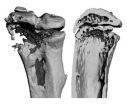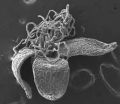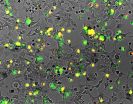(Press-News.org) (Santa Barbara, Calif.) –– Scientists at UC Santa Barbara are researching cocaine addiction, part of a widespread problem, which, along with other addictions, costs billions of dollars in damage to individuals, families, and society. Laboratory studies at UCSB have revealed that the diminished brain function and learning impairment that result from cocaine addiction can be treated –– and that learning can be restored.
Karen Szumlinski, a professor in the Department of Psychological & Brain Sciences at UCSB, and her colleagues Osnat Ben-Shahar and Tod Kippin, have worked in the field of addiction for many years. Senior author of a paper on this topic published recently in The Journal of Neuroscience, Szumlinski is particularly interested in the part of the brain called the prefrontal cortex, where the process of "executive function" –– or decision-making –– is located. This area is involved in directing one's behavior in an appropriate manner, and in controlling behavior.
With her research team, Szumlinski discovered that a drug that stimulates a certain type of glutamate receptor –– when aimed at the prefrontal cortex –– could restore learning impairment in rats with simulated cocaine addiction.
"Needless to say, this (the prefrontal cortex) is one of the last parts of the brain to develop, and, of relevance to our students, continues to develop through about age 25 to 28," said Szumlinski.
Szumlinski explained that in the prefrontal cortex there seems to be "hypo-frontality," or reduced functioning, in drug addicts, as well as in patients with a range of neuropsychiatric diseases, including schizophrenia, depression, and attention deficit disorder.
Szumlinski calls the prefrontal cortex a late-developing brain area that is critical for making proper decisions, and inhibiting behavior. "You damage this brain region and you lose the ability to self-regulate, you make impulsive decisions like engaging in risky sexual behavior or drug-taking, you basically go off the deep end in terms of function," she said. "So we were very much interested in how drugs of abuse impact the prefrontal cortex, given that human drug addicts show deficits in this brain area when you put them into a scanner. They show hypo-activity." She said this hypo-activity, or hypo-frontality, might relate to a neurotransmitter that scientists know is involved in exciting the brain.
A key question, according to Szumlinski, is this: "Was that hypo-frontality there in the first place, and that's why they became an addict; or did the drugs change their prefrontal cortext, to cause it to become hypo-functioning and thus they're not able to control their drug use? You can't parse that out in humans. So that's why we turn then to animal models of the disorder, and we do have this rat model that we use in the paper."
Szumlinski pointed out a key difficulty in the development of treatments for addiction: There is little money targeted to the study of this disease. Hence, in addition to studying the brain mechanisms that are involved, she is joining forces with researchers who study other neurological diseases that are well-funded, to help find cures. She hopes that government approval of new drugs for these other diseases would eventually make the drugs available for clinical trials to study their effects on cocaine addiction.
Szumlinski cited statistics, calculated by scientists M.K. Bird and A.J. Lawrence of Australia, indicating that addiction can cost up to 3.5 percent of gross domestic product in Western countries, equaling $485 billion in the U.S. in 2007. In that year, addiction research received less than 2 percent of public and private funding of all cancer research.
INFORMATION:
Co-authors of the paper are Osnat Ben-Shahar, Tod E. Kippin, Arianne D. Sacramento, Bailey W. Miller, Sierra M. Webb, Melissa G. Wroten, Hannah E. Silva, Amanda L. Caruana, Evan J. Gordon, Kyle L. Ploense, and Jennifer Ditzhazy, all from UCSB's Department of Psychological and Brain Sciences, and the Neuroscience Research Institute.
The study was funded by the National Institutes of Health and by grants from the Academic Senate at UCSB.
UCSB study of cocaine addiction reveals targets for treatment
2013-02-13
ELSE PRESS RELEASES FROM THIS DATE:
Emerging cancer drugs may drive bone tumors
2013-02-13
Cancer drugs should kill tumors, not encourage their spread. But new evidence suggests that an otherwise promising class of drugs may actually increase the risk of tumors spreading to bone, according to researchers at Washington University School of Medicine in St. Louis.
The drugs, IAP antagonists, block survival signals that many cancer cells rely on to stay alive. Working in mice, the investigators found that targeting the same protein that makes tumors vulnerable to death also overactivates cells called osteoclasts, which are responsible for tearing down bone.
"These ...
Flu outbreaks modeled by new study of classroom schedules
2013-02-13
Classroom rosters combined with human-networking theory may give a clearer picture of just how infectious diseases such as influenza can spread through a closed group of people, and even through populations at large. Using high-school schedule data for a community of students, teachers, and staff, Penn State University's Marcel Salathé, an assistant professor of biology, and Timo Smieszek, a post-doctoral researcher, have developed a low-cost but effective method to determine how to focus disease-control strategies based on which individuals are most likely to spread the ...
Does race make a difference in monitoring of opioid pain therapy?
2013-02-13
Philadelphia, PA, February 12, 2013 – Opioids are frequently prescribed for pain management in noncancer patients, but recommended clinical guidelines for monitoring effectiveness and signs of drug abuse are often not implemented. Alongside well-documented racial disparities in prescribing opioid medications for pain, researchers report racial differences in the use of recommended opioid monitoring and follow-up treatment practices. The study is published in the current issue of PAIN®.
"In our study, we examined whether racial disparities exist in a more comprehensive ...
Ice age extinction shaped Australian plant diversity
2013-02-13
Researchers have shown that part of Australia's rich plant diversity was wiped out by the ice ages, proving that extinction, instead of evolution, influences biodiversity.
The research led by the University of Melbourne and University of Tasmania has shown that plant diversity in South East Australia was as rich as some of the most diverse places in the world, and that most of these species went extinct during the ice ages, probably about one million years ago.
The team's work was published in the prestigious journal Proceedings of the National Academy of Sciences.
Dr ...
Flood research shows human habits die hard
2013-02-13
New research has come up with ways to quickly assess flood damage to houses while also showing most people didn't intend to make changes to reduce their vulnerability after the 2010-11 floods in Australia.
Two separate reports from the National Climate Change Adaptation Research Facility released today show how lessons learned from households affected by the 2010-11 Australian floods can minimise damage under current and future climates.
The report Analysis of Damage to Buildings Following the 2010 Eastern Australia Floods evaluated the role of development controls ...
Blackbirds in the spotlight
2013-02-13
This press release is available in German.
Street lamps, traffic lights and lighting from homes are causing a rise in our night-time light levels. For some time now, scientists have suspected that artificial light in our towns and cities at night could affect plants, animals and us, humans, too. Studies, however, that have tested this influence directly are few. Scientists from the Max Planck Institute for Ornithology in Radolfzell, Germany, recently investigated how light conditions in urban areas at night affect European blackbirds (Turdus merula). They found that animals ...
Copper depletion therapy keeps high-risk triple-negative breast cancer at bay
2013-02-13
NEW YORK (February 13, 2013) -- An anti-copper drug compound that disables the ability of bone marrow cells from setting up a "home" in organs to receive and nurture migrating cancer tumor cells has shown surprising benefit in one of the most difficult-to-treat forms of cancer -- high-risk triple-negative breast cancer.
The median survival for metastatic triple-negative breast cancer patients is historically nine months. However, results of a new phase II clinical trial conducted by researchers at Weill Cornell Medical College and reported in the Annals of Oncology shows ...
UNC researchers discover gene that suppresses herpesviruses
2013-02-13
Chapel Hill, NC – Kaposi's sarcoma-associated herpesvirus (KSHV) and Epstein-Barr virus (EBV) hide within the worldwide human population. While dormant in the vast majority of those infected, these active herpesviruses can develop into several forms of cancer. In an effort to understand and eventually develop treatments for these viruses, researchers at the University of North Carolina have identified a family of human genes known as Tousled-like kinases (TLKs) that play a key role in the suppression and activation of these viruses.
In a paper published by Cell Host ...
'A drop of ink on the luminous sky'
2013-02-13
This part of the constellation of Sagittarius (The Archer) is one of the richest star fields in the whole sky -- the Large Sagittarius Star Cloud. The huge number of stars that light up this region dramatically emphasise the blackness of dark clouds like Barnard 86, which appears at the centre of this new picture from the Wide Field Imager, an instrument mounted on the MPG/ESO 2.2-metre telescope at ESO's La Silla Observatory in Chile.
This object, a small, isolated dark nebula known as a Bok globule [1], was described as "a drop of ink on the luminous sky" by its discoverer ...
Study suggests infant deaths can be prevented
2013-02-13
(TORONTO, Canada – Feb. 13, 2013) – An international team of tropical medicine researchers have discovered a potential method for preventing low birth weight in babies born to pregnant women who are exposed to malaria. Low birth weight is the leading cause of infant death globally.
The findings of Malaria Impairs Placental Vascular Development, published today online ahead of print in Cell Host & Microbe, showed that the protein C5a and its receptor, C5aR, seem to control the blood vessel development in the mother's placenta. Without adequate blood vessels in the placenta, ...




